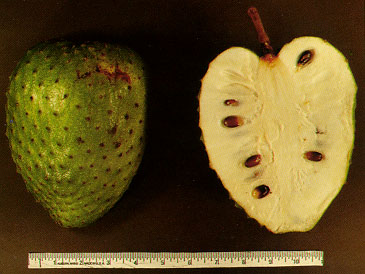- Soursop
taxobox
name = Soursop
image_caption = Soursop fruit
regnum =Plant ae
unranked_divisio =Angiosperm s
unranked_classis =Magnoliid s
ordo =Magnoliales
familia =Annonaceae
genus = "Annona "
species = "A. muricata"
binomial = "Annona muricata"
binomial_authority = L. [cite web
url=http://www.ars-grin.gov/cgi-bin/npgs/html/taxon.pl?3492
title=Annona muricata information from NPGS/GRIN
publisher=www.ars-grin.gov
accessdate=2008-03-03
last=
first=] |The soursop (Spanish guanábana, Portuguese graviola), "Annona muricata";
syn. "Annona sericea" Dunal in Correia, M. P., (1984), "Annona macrocarpa" Wercklé, "A. bonplandiana" H.B. & K., "A. cearensis"Barb.Rodr. , "Guanabanus muricatus" (L.) M.Gómez in Rain-tree) is a broadleaf floweringevergreen tree native toMexico ,Central America , theCaribbean and northernSouth America . Today, it is also grown in some areas ofSoutheast Asia . It is in the same genus as thecherimoya and the same family as thepawpaw . In most Spanish speaking countries it is commonly known as Guanábana. In thePhilippines , it is known as guyabano.The soursop is adapted to areas of high humidity and relatively warm winters, temperatures below 5 °C will cause damage to leaves and small branches, and temperatures below 3 °C can be fatal.
Comparisons of its flavour range from
strawberry andpineapple mixed together to sourcitrus flavour notes contrasting with an underlying creamy roundness of flavour reminiscent ofcoconut orbanana . The fruit is somewhat difficult to eat, as the white interior pulp is studded with many large seeds, and pockets of soft flesh are bounded by fibrous membranes. The soursop is therefore usually juiced rather than eaten directly.Cultivation and uses
The plant is grown as a commercial crop for its 20-30 cm long prickly green
fruit , which can have a mass of up to 2.5 kg.Away from its native area, there is some limited production as far north as southern
Florida withinUSDA Zone 10; however these are mostly garden plantings for local consumption. It is also grown in parts of southeasternAsia . The soursop will reportedly fruit as a container specimen, even in temperate climates if protected from cool temperatures.The flesh of the fruit consists of an edible white pulp and a core of undigestible black seeds. The species is the only member of the genus "
Annona " that is suitable for processing and preservation. The sweet pulp is used to make juice as well as candies, sorbets, and ice cream flavorings.In
Mexico it is a common fruit often used for dessert as the only ingredient, or as anagua fresca beverage. Ice cream, and fruit bars made of soursop are also very popular. The seeds are normally left in the preparation, and removed while consuming.Nutritionally, the fruit is high in
carbohydrates , particularlyfructose . The fruit also contains significant amounts ofvitamin C ,vitamin B1 , andvitamin B2 . The fruit, seeds, and leaves have a number of herbal medicinal uses among indigenous peoples of regions where the plant is common.In the Caribbean it is believed that laying the leaves of the soursop on a bed below a sleeping person with a fever will break the fever by the next morning. Also, boiling the leaves and drinking may help induce sleep.cite web
title = Tropical Plant Database:GRAVIOLA (Annona muricata)
publisher =Raintree Nutrition
url =http://www.rain-tree.com/graviola.htm
accessdate = 2006-12-13]The tea, fruit, and juice are used medicinally to treat illness ranging from stomach ailments to worms.
Health risks
Research carried out in the Caribbean has suggested a connection between consumption of soursop and atypical forms of
Parkinson's disease due to the very high concentration ofannonacin .cite journal
last =Lannuzel
first =A
coauthors = et al.
title =The mitochondrial complex i inhibitor annonacin is toxic to mesencephalic dopaminergic neurons by impairment of energy metabolism
journal =Neuroscience
volume =121
issue =2
pages =287–296
publisher =International Brain Research Organization
date = 2003-10-06
accessdate =2006-12-13
doi =10.1016/S0306-4522(03)00441-X ] [cite journal
last =Champy
first =Pierre
coauthors = et al.
title =Quantification of acetogenins in Annona muricata linked to atypical parkinsonism in guadeloupe
journal =Movement Disorders
volume =20
issue =12
pages =1629–1633
publisher =
date = 2005-08-02
accessdate =
doi =10.1002/mds.20632 ] [ cite journal | title = Is atypical parkinsonism in the Caribbean caused by the consumption of Annonacae? | pmid = 17017523 | journal = J Neural Transm Suppl. | year = 2006 | pages = 153–7 | issue = 70 | author = Lannuzel A, Höglinger GU, Champy P, Michel PP, Hirsch EC, Ruberg M. | doi = 10.1007/978-3-211-45295-0_24 | volume = 70] [ cite journal | pmid = 10440304 | date = 1999 Jul 24 | volume = 354 | issue = 9175 | pages = 281–6 | title = Possible relation of atypical parkinsonism in the French West Indies with consumption of tropical plants: a case-control study | author = Caparros-Lefebvre D, Elbaz A.]External links
* Correia, M. P., (1984) "Dicionário das plantas úteis do Brasil"
* [http://www.hort.purdue.edu/newcrop/morton/soursop.html Description of soursop] from "Fruits of Warm Climates" (1987, ISBN 0-9610184-1-0)
* [http://www.plantnames.unimelb.edu.au/Sorting/Annona.html Sorting Annona names]
* [http://www.philippineherbalmedicine.org/guyabano.htm Soursop / Guyabano Fruit Nutrition]
* [http://www.rain-tree.com/Graviola-Monograph.pdf Rain-tree: "Annona muricata"]
* [http://sun.ars-grin.gov:8080/npgspub/xsql/duke/plantdisp.xsql?taxon=91 Soursop List of Chemicals (Dr. Duke's)]References
ee also
*
Cherimoya
*Custard-apple
*Sugar-apple
Wikimedia Foundation. 2010.
